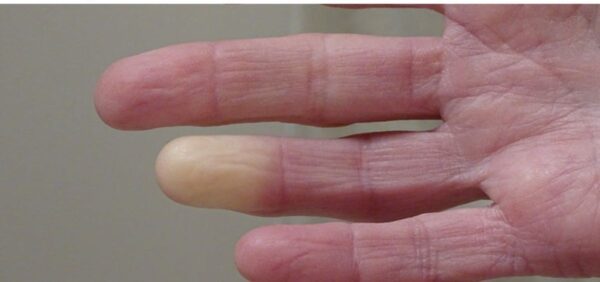What Do Constantly Cold Hands and Feet Indicate?
I Had No Idea It Could Be This Serious!

You’ve probably heard the common expression: “Cold hands, warm heart.”
While it’s a charming sentiment, the reality is that cold hands and feet can be more than just a quirky trait or response to weather. They can actually be a sign of your body’s way of adapting to external temperatures — or an indicator of underlying health problems.
According to research and statistics, women are more likely to suffer from cold extremities than men. Though it can sometimes be benign, it’s important not to ignore this symptom, especially when it occurs frequently or persists despite warm conditions.
Common Causes of Cold Hands and Feet
There are several potential causes for this issue, and understanding them is key to finding the right solution. Let’s look at the most frequent ones:
1. Hypothyroidism (Underactive Thyroid)
One of the most common causes is hypothyroidism, a condition in which the thyroid gland doesn’t produce enough hormones. Since the thyroid regulates the body’s overall metabolism, when it’s underactive, everything slows down — including your body’s ability to maintain warmth.
With a sluggish metabolism, the body becomes less efficient at generating heat, often leading to cold sensations in the hands and feet. Other symptoms may include fatigue, weight gain, dry skin, and depression.
2. Anemia (Iron Deficiency or Vitamin Deficiency)
Anemia is another frequent culprit. When the body has too few red blood cells or insufficient hemoglobin, it can’t transport oxygen effectively. This leads to a drop in core temperature, causing extremities to feel cold.
Iron-deficiency anemia is especially common in women due to menstruation, and it can be worsened by poor diet or absorption issues. In addition to cold hands and feet, people with anemia may also feel weak, dizzy, or short of breath.
3. Diabetes and Peripheral Neuropathy
For people with diabetes, a condition called peripheral neuropathy may develop over time. This refers to nerve damage in the limbs caused by elevated blood sugar levels.
Neuropathy can make your hands and feet feel cold or numb, even when their surface temperature is normal. In some cases, nerve damage may also lead to burning, tingling, or loss of sensation, making injuries more likely.
4. Thoracic Outlet Syndrome and Circulatory Issues (Like Raynaud’s Disease)
Thoracic Outlet Syndrome (TOS) is a lesser-known condition but an important one to mention. It occurs when nerves or blood vessels are compressed as they exit the chest and travel into the arms.
This compression can result from poor posture, injury, or anatomical abnormalities, and it can affect blood flow, causing cold hands or a feeling of weakness. TOS is more common in women, especially those with underdeveloped upper-body muscles or a history of slouching.
Similarly, Raynaud’s disease is a circulatory disorder where small arteries narrow dramatically in response to cold or stress. This reduces blood flow to the fingers and toes, leading to a white or blue color, followed by a red flush when circulation returns. It is not only uncomfortable but can be painful and damaging over time.
Why Are Women More Affected?
Several factors contribute to women being more prone to these conditions:
The female endocrine system is more complex and sensitive to hormonal fluctuations.
Menstruation can cause recurring iron-deficiency anemia.
Muscular underdevelopment and postural issues may increase susceptibility to conditions like TOS.
Even outside of medical conditions, women’s lower average muscle mass may mean they generate less internal heat, contributing to cold extremities in colder environments.
What Can You Do About Cold Hands and Feet?
The best course of action depends on the root cause, but here are several general and condition-specific strategies you can follow:
1. Dress for Warmth
In cold seasons, always wear gloves, warm socks, and layered clothing to trap body heat. Keeping your core body warm helps maintain circulation to your hands and feet.
2. Aerobic Exercise
Engaging in regular aerobic activity improves blood flow and helps your body regulate its internal temperature. Exercise encourages capillary expansion, allowing more blood to reach your extremities.
Walking, cycling, swimming, or even brisk house cleaning can make a difference.
3. Dietary Adjustments for Anemia
If anemia is the cause, correct it through your diet:
Eat iron-rich foods like leafy greens (spinach, kale), red meat (especially liver), beans, lentils, and fortified cereals.
Cook with cast-iron pans – this naturally boosts iron levels in food.
Include vitamin C (found in fruits like oranges and berries) to improve iron absorption.
Iron or B12 supplements may also be recommended by your doctor.
4. Posture & Muscle Strength
For Thoracic Outlet Syndrome, focus on correcting posture and strengthening the upper back and chest muscles. Simple stretching and strengthening exercises can reduce compression on nerves and blood vessels.
Examples include:
Shoulder rolls
Wall angels
Resistance band pull-aparts
Consult a physical therapist if you suspect posture or nerve compression is an issue.
5. Medical Treatment for Underlying Conditions
If your symptoms are persistent or severe, it’s crucial to consult a healthcare provider. You may need blood tests to check for:
Thyroid hormone levels
Iron levels
Vitamin B12 or folate
Blood sugar (for diabetes)
Circulatory function (via Doppler ultrasound)
Early diagnosis and treatment can prevent complications.
Don’t Ignore the Warning Signs
Cold hands and feet aren’t always just a reaction to a chilly room. They can be a red flag your body is using to alert you that something deeper is going on. While it may seem like a minor inconvenience, the underlying causes can be serious — and sometimes even life-threatening if left untreated.
The worst thing you can do is ignore the symptoms or assume they’ll go away on their own. The best approach is to take proactive steps: adjust your habits, eat well, stay active, and seek medical advice when necessary.
Final Thoughts
Cold hands and feet are more than a nuisance — they can be a signal from your body asking for attention. Whether it’s due to anemia, thyroid dysfunction, poor circulation, or simply lifestyle habits, there are many ways to treat and prevent this condition.
Taking care of your overall health, being mindful of changes, and acting early can make all the difference. After all, warm hands and feet don’t just feel good — they’re often a sign that your body is functioning exactly as it should.












